Mechanism of constitutive export from the golgi: bulk flow via the formation, protrusion, and en bloc cleavage of large trans-golgi network tubular domains
- PMID: 12937271
- PMCID: PMC266766
- DOI: 10.1091/mbc.e03-01-0033
Mechanism of constitutive export from the golgi: bulk flow via the formation, protrusion, and en bloc cleavage of large trans-golgi network tubular domains
Abstract
Transport of constitutive cargo proteins from the Golgi complex to the plasma membrane (PM) is known to be mediated by large tubular-saccular carriers moving along microtubules. However, the process by which these large structures emerge from the trans-Golgi network (TGN) remains unclear. Here, we address the question of the formation of Golgi-to-PM carriers (GPCs) by using a suitable cluster of morphological techniques, providing an integrated view of their dynamics and three-dimensional structure. Our results indicate that exit from the TGN of a constitutive traffic marker, the VSVG protein, occurs by bulk flow and is a three-step process. First, the formation of a tubular-reticular TGN domain (GPC precursor) that includes PM-directed proteins and excludes other cargo and Golgi-resident proteins. Notably, this step does not require membrane fusion. Second, the docking of this preformed domain on microtubules and its kinesin-mediated extrusion. Finally, the detachment of the extruded domain by membrane fission. The formation of GPCs does not involve cargo concentration and is not associated with the presence of known coat proteins on GPC precursors. In summary, export from the Golgi occurs via the formation, protrusion and en bloc cleavage of specialized TGN tubular-saccular domains.
Figures
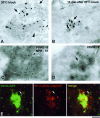
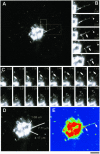
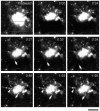
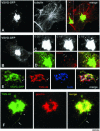
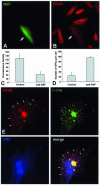
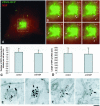
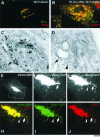


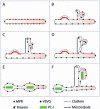
Similar articles
-
ER-to-Golgi carriers arise through direct en bloc protrusion and multistage maturation of specialized ER exit domains.Dev Cell. 2003 Oct;5(4):583-94. doi: 10.1016/s1534-5807(03)00294-6. Dev Cell. 2003. PMID: 14536060
-
Dual-color visualization of trans-Golgi network to plasma membrane traffic along microtubules in living cells.J Cell Sci. 1999 Jan;112 ( Pt 1):21-33. doi: 10.1242/jcs.112.1.21. J Cell Sci. 1999. PMID: 9841901
-
Membrane flow through the Golgi apparatus: specific disassembly of the cis-Golgi network by ATP depletion.J Cell Sci. 1999 Nov;112 ( Pt 22):4017-29. doi: 10.1242/jcs.112.22.4017. J Cell Sci. 1999. PMID: 10547362
-
Morphogenesis of post-Golgi transport carriers.Histochem Cell Biol. 2008 Feb;129(2):153-61. doi: 10.1007/s00418-007-0365-8. Epub 2008 Jan 23. Histochem Cell Biol. 2008. PMID: 18214517 Free PMC article. Review.
-
Molecular mechanisms responsible for formation of Golgi ribbon.Histol Histopathol. 2011 Jan;26(1):117-33. doi: 10.14670/HH-26.117. Histol Histopathol. 2011. PMID: 21117033 Review.
Cited by
-
The many routes of Golgi-dependent trafficking.Histochem Cell Biol. 2013 Sep;140(3):251-60. doi: 10.1007/s00418-013-1124-7. Epub 2013 Jul 12. Histochem Cell Biol. 2013. PMID: 23846822 Review.
-
Glycans function as a Golgi export signal to promote the constitutive exocytic trafficking.J Biol Chem. 2020 Oct 23;295(43):14750-14762. doi: 10.1074/jbc.RA120.014476. Epub 2020 Aug 21. J Biol Chem. 2020. PMID: 32826314 Free PMC article.
-
Biogenesis of tubular ER-to-Golgi transport intermediates.Mol Biol Cell. 2006 Feb;17(2):723-37. doi: 10.1091/mbc.e05-06-0580. Epub 2005 Nov 28. Mol Biol Cell. 2006. PMID: 16314391 Free PMC article.
-
Differential sorting and Golgi export requirements for raft-associated and raft-independent apical proteins along the biosynthetic pathway.J Biol Chem. 2008 Jun 27;283(26):18040-7. doi: 10.1074/jbc.M802048200. Epub 2008 Apr 22. J Biol Chem. 2008. PMID: 18434305 Free PMC article.
-
Clathrin terminal domain-ligand interactions regulate sorting of mannose 6-phosphate receptors mediated by AP-1 and GGA adaptors.J Biol Chem. 2014 Feb 21;289(8):4906-18. doi: 10.1074/jbc.M113.535211. Epub 2014 Jan 9. J Biol Chem. 2014. PMID: 24407285 Free PMC article.
References
-
- Acharya, U., Jacobs, R., Peters, J.M., Watson, N., Farquhar, M.G., and Malhotra, V. (1995). The formation of Golgi stacks from vesiculated Golgi membranes requires two distinct fusion events. Cell 82, 895-904. - PubMed
-
- Band, A.M., Maatta, J., Kaariainen, L., and Kuismanen, E. (2001). Inhibition of the membrane fusion machinery prevents exit from the TGN and proteolytic processing by furin. FEBS Lett. 505, 118-124. - PubMed
-
- Banting, G., and Ponnambalam, S. (1997). TGN38 and its orthologues: roles in post-TGN vesicle formation and maintenance of TGN morphology. Biochim. Biophys. Acta 1355, 209-217. - PubMed
-
- Brown, W.J., Chambers, K., and Doody, A. (2003). Phospholipase A2 (PLA2) enzymes in membrane trafficking: mediators of membrane shape and function. Traffic 4, 214-221. - PubMed
Publication types
MeSH terms
Substances
Grants and funding
LinkOut - more resources
Full Text Sources
Research Materials
Miscellaneous

